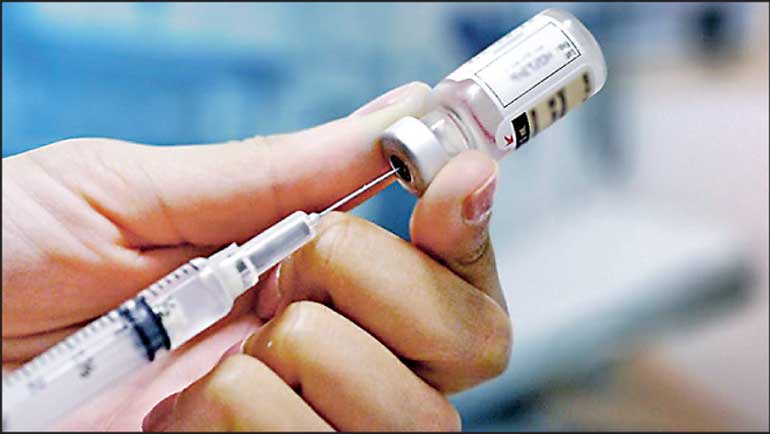Monday Apr 21, 2025
Monday Apr 21, 2025
Tuesday, 20 February 2024 00:39 - - {{hitsCtrl.values.hits}}

IV drug manufacture is not a simple undertaking
By Geewananda Gunawardana, Ph. D.
Medicinal drugs can be divided into three major categories depending on their route of administration to patients: oral, parenteral, and topical forms. The parenteral (par = beyond, enteral = intestines) means administration not involving the intestinal or oral route. The parenteral drugs can be further classified in to four types depending on the site of administration: intravenous, intramuscular, subcutaneous, and intradermal drugs. The aim of this write up is to highlight the safety precautions involved in the manufacture of intravenous drugs as their quality, or lack of it, can be a matter of life or death for the patient.
Human skin and the lining of the alimentary canal, the epithelium, function as protective barriers preventing many environmental or food borne pathogens from entering vital organs and tissues. For example, snake bites can be lethal, but getting venom on intact skin or ingestion by a healthy person does not pose the same risk. Venoms, which are proteinaceous in nature, are digested just like any other protein and rendered harmless. On the other hand, despite its nutritious value, injection of milk intravenously is deadly. There are mechanisms to neutralise and eliminate most food borne pathogens in healthy individuals to a certain extent. However, patients are a different class as their protective mechanisms can be weakened; therefore, any form of medication is expected to meet high standards of safety and quality, but intravenous drugs require much higher standards.
Intravenous drugs (IV drugs) are directly injected into the blood stream. As a result, they bypass almost all protective mechanisms that the body has in place; and substances that are ubiquitous in our environment and are otherwise harmless, must be painstakingly eliminated fully and completely from IV drugs. Therefore, extraordinary measures must be taken to prevent contamination with such harmful substances and pathogens during manufacture, storage, and administration of IV drugs. These challenges become even harder when the drugs are derived from biological sources, as is the case with immunoglobulin that has drawn much attention lately. That is in addition to ensuring the efficacy of the drug, which is another challenge that is not addressed here.
What are the substances that must be painstakingly removed? Microorganisms including bacteria, fungi, amoeba, and their spores are the first concern. They can be eliminated by applying heat, but in the case of biologics such as immunoglobulin, heat, or terminal sterilisation as it is known, cannot be applied as heat denatures the drug. Avoiding contamination of not just the drug, but any excipients and solvents etc. used, is also critical as even if the living microorganisms are destroyed, the chemicals they produce, known as endotoxins and pyrogens, survive posing serious risks. Therefore, contamination with microorganisms must be avoided throughout the supply chain, which includes water used anywhere during the process. Yes, water sounds innocuous enough, but drinking water is not good enough for IV injections. The purification of water used in IV drug manufacture is yet another involved process.
The next concern is the presence of viruses, especially when drugs come from biological sources. There are many viruses that can be transmitted this way, but the most concerned ones are Hepatitis, Human Immunodeficiency Virus (HIV), and Human T-Cell Lymphotrophic Virus. They are removed through complex filtration methods. Another concern is a type of protein known as prions, the causative agent of mad cow disease (BSE/TSE). This becomes an issue if dairy products such as lactose are used as an excipient.
It is also necessary to ensure that the materials used for the manufacture of containers and closures used to store and package the drug are compatible with it. Many plastics and metals tend to shed some of their constituents to the contents even if they do not come direct contact. They are known as extractables and leachable, and there must be procedures in place to avoid such contamination.
To keep IV drugs safe and efficacious, the regulatory agencies have produced stringent guidelines, which the pharmaceutical manufacturers follow diligently. There are three aspects to these practices. Primarily, there must be appropriate facilities that are approved by the regulatory agency and inspected regularly for compliance. For example, the air and water in such facilities must meet specifications given in guidance. Second, the personnel must be appropriately trained, and tested routinely for their proficiency in following Good Manufacturing Practices (GMP). Third, there must be procedures in place to ensure that GMP are followed and traceable from cradle to grave of the drug.
Therefore, IV drug manufacture is not a simple undertaking; even in the developed world there are only a limited, specialised organisations that can manufacture safe and efficacious IV drugs. For example, the shortage of several IV drugs in the USA last year was caused when one manufacturing facility was taken offline. Making sure that all safety measures are taken, and the drug stays safe all the way to the patient’s bedside is a gargantuan task that everyone involved takes very seriously. This writer has worked for a major IV drug manufacturer in the USA, and the supreme question in the minds of all involved was “Would you give this drug to your loved ones, or take it yourself if the need arises?” If there was any doubt, that drug would never leave the facility. Yes, there were serious repercussions for failure to do so, but more than anything else, it was a moral and ethical obligation one has to fellow humans who are in vulnerable situations that drove that conscience. It is unthinkable that any creature would neglect such sacred values with total disregard for life that they are elected or selected to safeguard. Sadly, not only such actions are criminal, but they also cast serious doubts about our calling them humans.